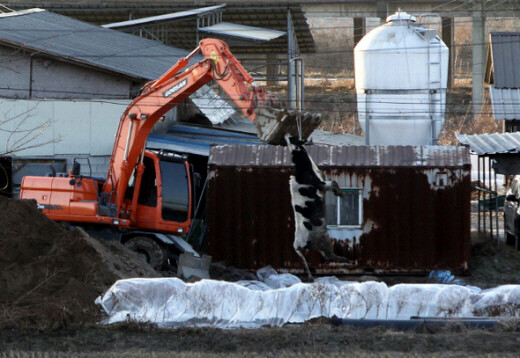hankyoreh
Links to other country sites 다른 나라 사이트 링크
Gyeonggi farms struck by foot-and-mouth disease

By Kim Hyun-dae, Senior Staff Writer
The foot-and-mouth disease outbreak that originated in Andong has spread to the northern part of South Korea in Gyeonggi Province. A record 170,000 animals have been targeted for burial to date. South Korea now finds itself facing the ignominy of being labeled a "repeat offender" for the disease.
The Ministry for Food, Agriculture, Forestry and Fisheries (MIFAFF) announced Wednesday that foot-and-mouth disease cases were found at two pig farms in Gyeonggi Province, one in Sangsu Village, Nam Township, Yangju, and another in Nogok 2-ri Village, Baekhak Township, Yeoncheon County. Both farms, located 17 km apart, are owned by the same farmer, leading analysts to suggest that the disease may have spread considerably as the owner moved around.
Other reports of suspected foot-and-mouth disease were received from two pig farms located near the Yeoncheon site and one in Bugok Village, Paju, some 15 km away.
The MIFAFF immediately started burying 700 cows and 15,925 pigs located within 500 meters of the two farms with confirmed foot-and-mouth disease cases. This brings the number of animals buried since Nov. 29 past the previous record of 160,155 set in 2002.
Because of the high density of livestock farming near the Yangju and Yeoncheon sites, the number of animals targeted for burial will instantaneously increase by an additional 67,000 if the scope of the targets is widened to a 3 km risk zone as it was in Andong.
Meanwhile, there is no sign of a letup in the foot-and-mouth outbreak in the North Gyeongsang Province area. An additional case was confirmed at a cattle farm in Majeon Village, Jibo Township, Yecheon County, while suspected cases were reported in Mungyeong and Yeongdeok.
The MIFAFF raised its crisis alarm level from the first stage, "caution," to the second stage, "alert," indicating a spread to two metropolitan cities or provinces. There are three total levels.
Please direct questions or comments to [englishhani@hani.co.kr]
Editorial・opinion
![[Column] Season 2 of special prosecutor probe may be coming to Korea soon [Column] Season 2 of special prosecutor probe may be coming to Korea soon](https://flexible.img.hani.co.kr/flexible/normal/500/300/imgdb/original/2024/0426/3317141030699447.jpg) [Column] Season 2 of special prosecutor probe may be coming to Korea soon
[Column] Season 2 of special prosecutor probe may be coming to Korea soon![[Column] Park Geun-hye déjà vu in Yoon Suk-yeol [Column] Park Geun-hye déjà vu in Yoon Suk-yeol](https://flexible.img.hani.co.kr/flexible/normal/500/300/imgdb/original/2024/0424/651713945113788.jpg) [Column] Park Geun-hye déjà vu in Yoon Suk-yeol
[Column] Park Geun-hye déjà vu in Yoon Suk-yeol- [Editorial] New weight of N. Korea’s nuclear threats makes dialogue all the more urgent
- [Guest essay] The real reason Korea’s new right wants to dub Rhee a founding father
- [Column] ‘Choson’: Is it time we start referring to N. Korea in its own terms?
- [Editorial] Japan’s rewriting of history with Korea has gone too far
- [Column] The president’s questionable capacity for dialogue
- [Column] Are chaebol firms just pizza pies for families to divvy up as they please?
- [Column] Has Korea, too, crossed the Rubicon on China?
- [Correspondent’s column] In Japan’s alliance with US, echoes of its past alliances with UK
Most viewed articles
- 1‘We must say no’: Seoul defense chief on Korean, USFK involvement in hypothetical Taiwan crisis
- 2Why Kim Jong-un is scrapping the term ‘Day of the Sun’ and toning down fanfare for predecessors
- 3Two factors that’ll decide if Korea’s economy keeps on its upward trend
- 4Gangnam murderer says he killed “because women have always ignored me”
- 5South Korea officially an aged society just 17 years after becoming aging society
- 6BTS says it wants to continue to “speak out against anti-Asian hate”
- 7After election rout, Yoon’s left with 3 choices for dealing with the opposition
- 8No good, very bad game for Korea puts it out of Olympics for first time since 1988
- 9Ethnic Koreans in Japan's Utoro village wait for Seoul's help
- 10US citizens send letter demanding punishment of LKP members who deny Gwangju Massacre